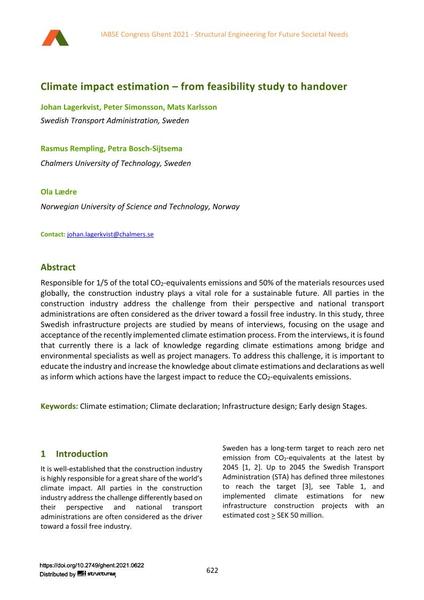Climate impact estimation – from feasibility study to handover

|
|
|||||||||||
Détails bibliographiques
| Auteur(s): |
Johan Lagerkvist
(Swedish Transport Administration, Sweden)
Peter Simonsson (Swedish Transport Administration, Sweden) Mats Karlsson (Swedish Transport Administration, Sweden) Rasmus Rempling Petra Bosch-Sijtsema (Chalmers University of Technology, Sweden) Ola Lædre (Norwegian University of Science and Technology, Norway) |
||||
|---|---|---|---|---|---|
| Médium: | papier de conférence | ||||
| Langue(s): | anglais | ||||
| Conférence: | IABSE Congress: Structural Engineering for Future Societal Needs, Ghent, Belgium, 22-24 September 2021 | ||||
| Publié dans: | IABSE Congress Ghent 2021 | ||||
|
|||||
| Page(s): | 622-628 | ||||
| Nombre total de pages (du PDF): | 7 | ||||
| DOI: | 10.2749/ghent.2021.0622 | ||||
| Abstrait: |
Responsible for 1/5 of the total CO₂-equivalents emissions and 50% of the materials resources used globally, the construction industry plays a vital role for a sustainable future. All parties in the construction industry address the challenge from their perspective and national transport administrations are often considered as the driver toward a fossil free industry. In this study, three Swedish infrastructure projects are studied by means of interviews, focusing on the usage and acceptance of the recently implemented climate estimation process. From the interviews, it is found that currently there is a lack of knowledge regarding climate estimations among bridge and environmental specialists as well as project managers. To address this challenge, it is important to educate the industry and increase the knowledge about climate estimations and declarations as well as inform which actions have the largest impact to reduce the CO₂-equivalents emissions. |
||||
| Copyright: | © 2021 International Association for Bridge and Structural Engineering (IABSE) | ||||
| License: | Cette oeuvre ne peut être utilisée sans la permission de l'auteur ou détenteur des droits. |
||||
